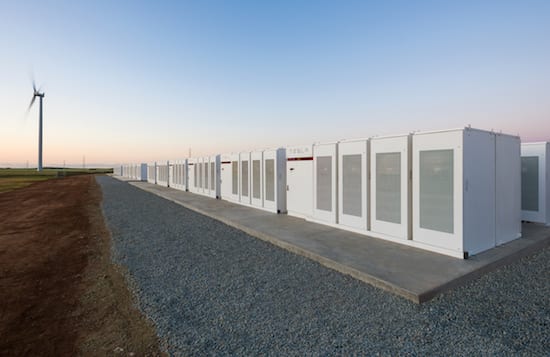Yet another grid-scale Tesla battery system is set to be paired with large-scale renewables in Australia, with Infigen Energy revealing plans to add a 25MW/52MWh energy storage system at its Lake Bonney wind farm in South Australia.
ASX-listed Infigen said on Wednesday construction of the $38 million system was expected to begin in coming weeks, backed by funding from the SA government ($5 million) and ARENA ($5 million).
The Powerpack battery energy storage system (BESS) will be located adjacent to the 278.5MW Lake Bonney wind farm and connected to the grid via the existing Mayurra substation owned by ElectraNet.
It is the third Tesla big battery to be located next to a wind farm in South Australia and more are to follow (see below), and another two Tesla big batteries are to be installed next to a solar farm in Victoria and another wind project in Victoria.
Infigen’s plans to add battery storage at Lake Bonney – which was built near Mt Gambier in three stages between 2005 and 2010 – were first flagged in May, buoyed by the fresh and surprising success of the Hornsdale Power Reserve.
That project – Australia’s original “big battery” installed at Hornsdale wind farm, also in SA – remains the largest of its kind in the world, to date, at 100MW/129MWh.
And as Steve Parker and Bruce Mountain wrote here, HPR continues to capture the attention of energy analysts, policy makers and market operators and investors, due to its impressive results on earnings, and particularly its apparently valuable ability to “dash in and out of the market.”
The Lake Bonney BESS, at around half the capacity, is expected to allow Infigen to firm at least an additional 18MW from the existing wind farm for commercial and industrial customers, depending on the customer load profile.
“With the firming capability of the BESS Infigen will be able to expand its supply contracts from the Lake Bonney Wind Farm to additional commercial and industrial customers in South Australia, which is at the heart of our business strategy,” said Infigen CEO Ross Rolfe.
And like the Hornsdale big battery, it will also be able to supply ancillary services to the grid, boosting supply security and quality and offering and fast response services as required.
One analyst noted that the size of the battery – small compared to the wind farm – makes sense because “it doesn’t need to be big to provide out-size benefits.”
The analyst noted that the battery removes what is known as the “frequency oscillation discount on Lake Bonney output” – i.e. it reduces costs – and will enable Infigen to bid more boldly in the market, or not bid at all when prices are low.
“The low-value midnight to dawn production can be stored and sold into the afternoon peak – and that is the widest arbitrage available in the electricity market,” the analyst said.
ARENA chief Ivor Frischknecht said battery storage – particularly in its ability to offer frequency control and ancillary services (FCAS) – was increasingly becoming a key component of transitioning to an renewables dominated energy system.
“It is clear that grid scale batteries have an important role in stabilising the grid. The co-location of a battery with a wind farm provides an opportunity for Infigen to pursue regulatory changes that could improve revenue outcomes for grid-scale batteries, helping to becoming more competitive,” he said.
“Infigen’s strategy is to supply clean energy to our customers and participate in growth opportunities in the NEM,” added Rolfe.
“Our investment in the BESS demonstrates our continued solid progress in delivering on our strategy. We are delighted to be able to work with global technology leader Tesla, ARENA and the South Australian Government to contribute to improved energy security and reliability of supply for South Australian energy consumers.”
SA’s relatively new energy minister, Dan van Holst Pellekaan, also welcomed Infigen’s investment.
“The (Liberal) Marshall government are strong supporters of increasing battery storage to harness the full potential of South Australia’s abundant renewable energy and the lower prices that will be delivered to households and businesses,” he said in comments on Wednesday.
Apart from Infigen, Electranet is installing a 30MW/8MWh battery at the Wattle Point wind farm on the Yorke Peninsula, and Nexif Energy is to add 10MW of battery storage to the new Lincoln Gap wind farm in Port Augusta, and the battery size could be tripled.
Tilt Renewables is also building a 21MW/26MWh battery storage facility along with a 44MW solar PV plant next to the Snowtown wind farm.
In Victoria, installation of a 25MW/50MWh battery system – also made up of Tesla Powerpacks – is underway at the 60MW Gannawarra Solar Farm in the state’s north-west, jointly owned by Wirsol Energy and Edify Energy.
While in May, works began on the Bulgana Green Power Hub in the regional town of Stawell – which will pair Tesla Powerpacks with Neoen’s Bulgana wind farm to deliver 100 per cent renewable energy to what will be the country’s biggest vegetable glasshouse, owned by Nectar Farms.








